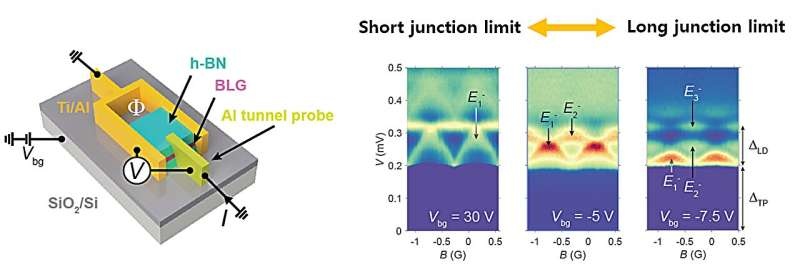Groundbreaking research has uncovered a new method to manipulate the quantum properties of Andreev bound states in superconducting devices using bilayer graphene-based Josephson junctions. This discovery paves the way for advancements in quantum computing and high-precision sensors.

Unlocking the Quantum Frontier
Superconductors are materials that exhibit zero electrical resistance under specific conditions, such as extremely low temperatures or high pressures. When a thin normal conductor is placed between two superconductors, a supercurrent flows through the normal conductor due to the proximity effect, where superconductivity extends into the normal conductor.
This device is known as a Josephson junction, and within the normal conductor, new quantum states called Andreev bound states are formed. These Andreev bound states are crucial for mediating the supercurrent flow, and the number of energy levels in these states determines the electrical properties of the Josephson junction.
The research team, led by Professors Gil-Ho Lee and Gil Young Cho from the Department of Physics at Pohang University of Science and Technology (POSTECH) in South Korea, along with collaborators from the National Institute for Materials Science (NIMS) in Japan, have found a way to control these Andreev bound states using gate voltage. By utilizing bilayer graphene, they were able to manipulate the quadratic energy dispersion and the superconducting coherence length in real-time, allowing them to observe the change in the Andreev bound states at different gate voltages.
Crossing the Short-to-Long Junction Divide
The number of energy levels in the Andreev bound states depends on the ratio of the conduction channel length (the length of the normal conductor) to the superconducting coherence length (the length along which the superconducting state can be maintained in the normal conductor).
When the conduction channel is short and the number of Andreev bound state levels is limited to a pair, the system is said to be in the short junction limit. Conversely, if there are more than two pairs, it is referred to as the long junction limit.
Previously, the Andreev bound states observed in Josephson junctions were predominantly seen in the short junction limit. However, in this study, the research team was able to observe the Andreev bound states in the long Josephson junction limit, a phenomenon that was previously uncommon.
By using gate voltage to control the bilayer graphene’s properties, the researchers were able to adjust the number of energy levels in the Andreev bound states, effectively transitioning the system from the short junction limit to the long junction limit. This remarkable ability to manipulate the quantum states in real-time opens up exciting possibilities for applications in quantum computing and high-precision quantum sensors.
Conclusion
The groundbreaking research conducted by the POSTECH and NIMS team has unlocked a new method to control the quantum mechanical properties of Andreev bound states in superconducting devices. By utilizing the unique properties of bilayer graphene, they were able to manipulate the energy levels of the Andreev bound states in real-time, effectively transitioning the system from the short junction limit to the long junction limit. This discovery paves the way for advancements in quantum computing and high-precision quantum sensors, as the ability to precisely control these quantum states can lead to significant breakthroughs in various fields of science and technology.
